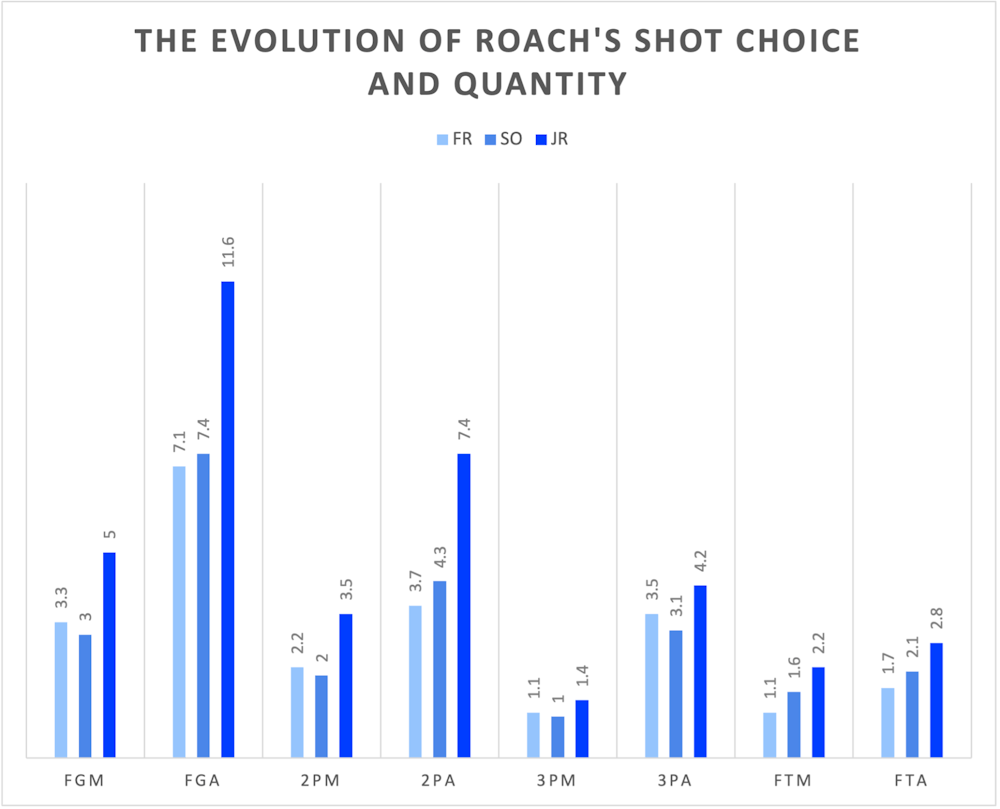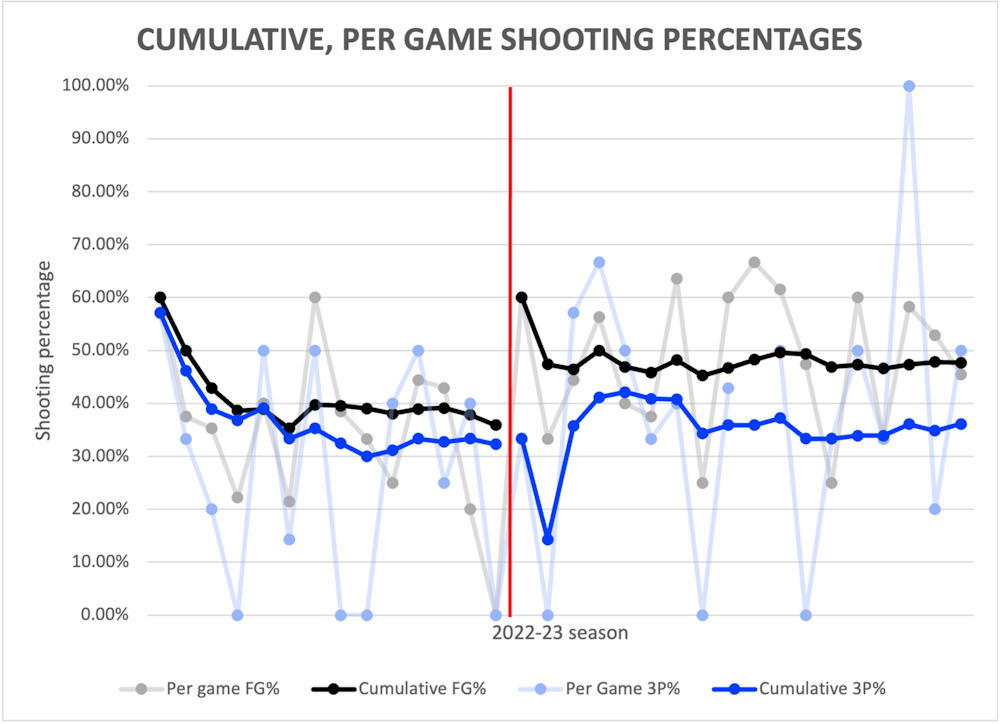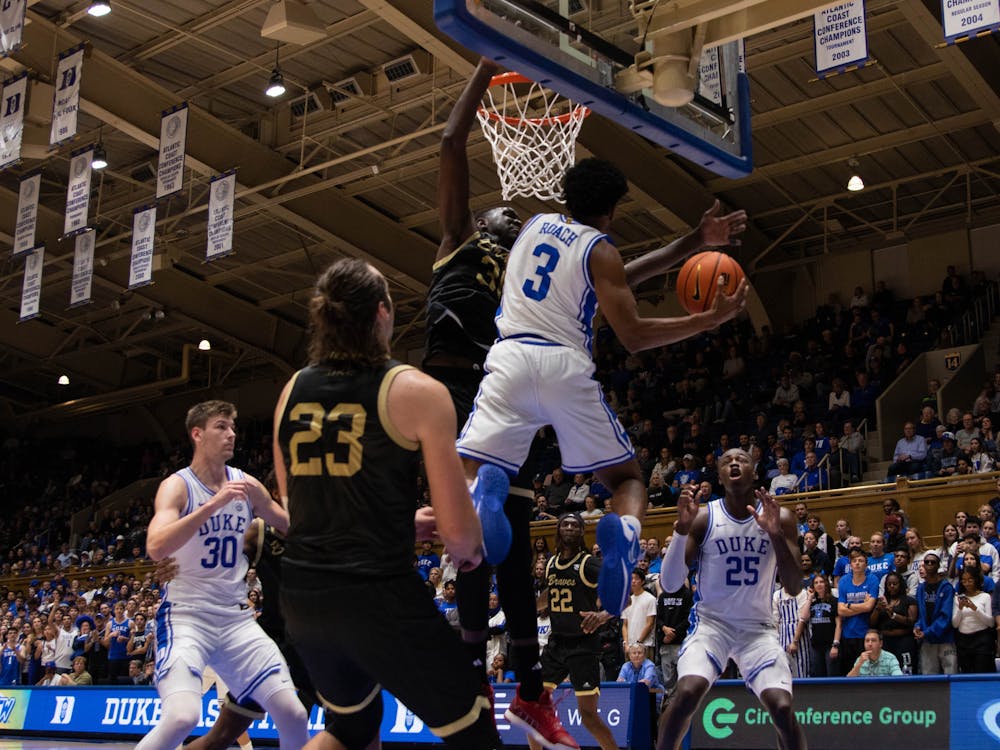You all know his name.
The senior. The captain. Lucky No. 3. Duke’s shining star in the 2022 NCAA tournament, its elder in a year of young guns and new beginnings.
Monday marks the start of Jeremy Roach’s fourth year at Cameron Indoor Stadium. He has played two positions under two head coaches, in front of the Cameron Crazies and with their absence painfully obvious, through No. 1 rankings and alongside No. 1 NBA Draft picks. One Final Four, one ACC title, 95 games and 75 starts. Roach is the cornerstone of this Blue Devil team, a moniker he has earned after three years of contribution.
For those who casually know Roach’s story and evolution, you may have heard of the slower start, the breakout March Madness performance, the junior year captainship and the transition from point guard to shooting guard. You know Roach is good at basketball, with his honorable mention All-ACC selection and team MVP honors last season.
But what are the stories and rhetoric based on? Let’s dive into the numbers behind Roach’s three years with the Blue Devils and what they can tell us about his fourth.
Through the years
Roach became a mainstay in the Blue Devil lineup as a freshman. He started 18 of the 24 games that year amidst a shortened — and unsuccessful, by Duke’s standards — COVID-19-riddled season. The St. Paul VI product averaged a respectable 8.7 points per game on 45.6% shooting from the floor. As a sophomore, roster turnover and injuries meant Roach’s role had to evolve as the season wore on, with the Leesburg, Va., native spending as many as nine straight games coming off the bench. When the NCAA tournament rolled around, he was planted back into the starting five and proved he had earned that promotion.
Last season, Roach served as the lone captain on a new-look Blue Devil team, initially playing the point until a toe injury sidelined him for three games in January. When he returned, he began playing more of an off-ball role and saw his offensive production skyrocket. The 6-foot-2 guard’s 13.6 points per game were good for second on the team, only behind Kyle Filipowski.
As an offensive entity, Roach’s evolution over his three years is more effectively visualized in terms of his shot attempts rather than his shooting percentage.

Figure 1 shows Roach’s shot attempts and makes per game throughout his three seasons. The largest jump from his sophomore to junior campaign is evidenced in his two-point shot attempts, which increased nearly twofold. With his two-point shot percentage actually decreasing over his three years, from 59.1% to 47.3% to the 47.5% he shot inside the arc last season, the increase in shot attempts must be the immediate contributor to his higher point totals.
Sophomore breakout
Roach started 27 of 39 games as a sophomore. With the shift in his usage over the season, his minutes naturally decreased from 35.2 to 23.0 per game. However, his point total remained fairly steady, from 8.6 to 8.7 points per game. The shot numbers were not the same either — Roach’s two-point attempts dropped from 4.9 as a starter to 3.0 off the bench.
The reason for the balanced scoring effort? A more efficient shot.

Figure 2 shows Roach’s sophomore year shooting percentages grouped by the type of shot and split by his starting status. There were dramatic increases in both his two-point and 3-point shooting percentage off the bench as compared to when he started, with a 10.5% jump in his two-point shot and a 19.0% leap in his long shot. In his sixth-man role through the end of the regular season and the ACC tournament, Roach had the opportunity to hone his shot and his skill, which enabled him to continue some of that success through a starting role in the NCAA tournament — when he shot 54.3% inside the arc — and then into his junior year.
A positional shift
In Duke’s Phil Knight Legacy loss to Purdue on Nov. 27, 2022, Roach injured his toe. While he played in the following three games, the then-junior was unable to practice, missing the Blue Devils’ Dec. 10 win against Maryland Eastern Shore. He returned for the first three games of the continuous conference slate, but was sidelined once again after Duke’s lopsided loss at N.C. State. In his absence, then-freshman — and now-co-captain — Tyrese Proctor stepped into the starting point guard role. Roach missed three games and was eased back into the action, coming off the bench against Miami and Virginia Tech. When he returned to the starting lineup, he did so mostly at the two, letting Proctor continue floor-general duties while the captain could play in more of an off-ball role.
Get The Chronicle straight to your inbox
Sign up for our weekly newsletter. Cancel at any time.
Looking at Roach’s points, assists, turnovers and total rebounds per game both before and after the injury, there is only one notable difference. Even in more of a shooting guard role, his assist numbers barely changed, dropping from 3.2 to 3.0. His turnovers increased from 2.1 to 2.3, and his rebounds decreased from 2.5 to 2.4. The shift was in his point totals — with the opportunity to take more shots, Roach’s points per game jumped from a respectable 11.9 to a more impressive 14.9.
This time around, his shot numbers didn’t change much, as he took less than one more field goal and had 0.4 fewer 3-point attempts per game. So let’s look at his shot percentages.

Figure 3 shows Roach’s cumulative and per-game field goal and 3-point shooting percentages throughout his junior season, with the red line signifying when he returned from that toe injury for good. The cumulative average restarts at his injury return mark, the Jan. 21 game against Miami. Looking at the solid black line, while it does take a few games to level out from each starting point, its ending point post-injury is significantly higher than before. Roach’s field-goal percentage through Jan. 4 was 35.9% — from Jan. 21 through the end of the season, it was 47.7%. While his 3-point shooting percentage did not see nearly as immense of a shift, it did increase from 32.3% to 36.1%.
By comparison, Roach’s field goal attempt numbers did not follow a similar trendline. He averaged 11.1 attempts before his hiatus and 12.0 thereafter. This shows that the senior’s scoring rise, unlike his year-over-year change, was due to his increased efficiency and better shot selection.
Amid all its changes, this is still Roach’s team. Duke has been where he has grown and developed, where he became the star he is now, with a spot on the Jerry West Award watch list and his name penciled onto a shortlist of four-year Blue Devil stars. The 22-year-old will lead an especially deep backcourt this year, and with the plethora of guards at head coach Jon Scheyer’s disposal, Roach will have to adapt, just as he has done through the past three years.
Whenever Roach and Proctor share the court, look for the senior’s production to follow a similar trend to his post-injury 2022-23 season, with moderate assist numbers but explosive scoring power in the shooting guard role. When Proctor is off, Roach may assume more of the point-guard role, calling an offense that will likely feature two freshmen in a small-ball lineup. Though Proctor’s time on the bench is likely minimal, Roach will be less of a scoring threat during those possessions as he commands a young offense.
Editor's note: this piece is one of many in The Chronicle's 2023-24 Duke men's basketball preview. Check out the rest here.

Rachael Kaplan is a Trinity senior and a senior editor of The Chronicle's 120th volume.

